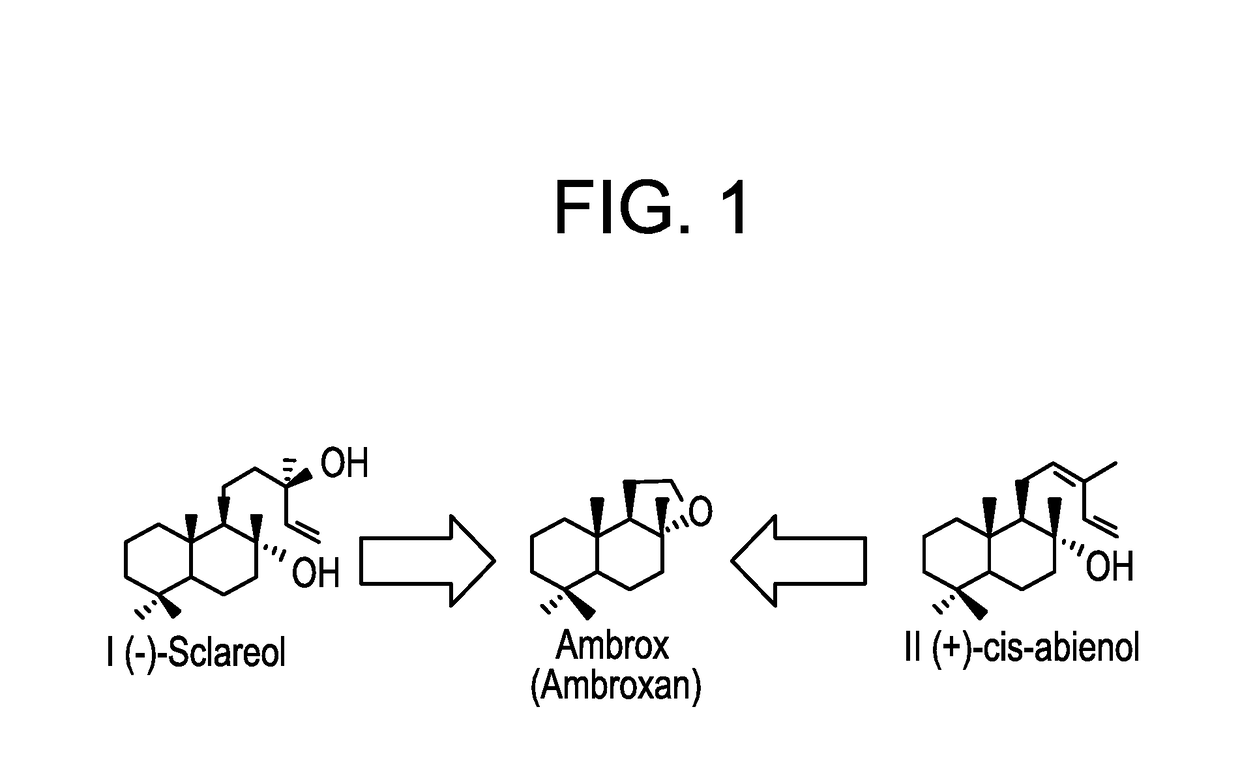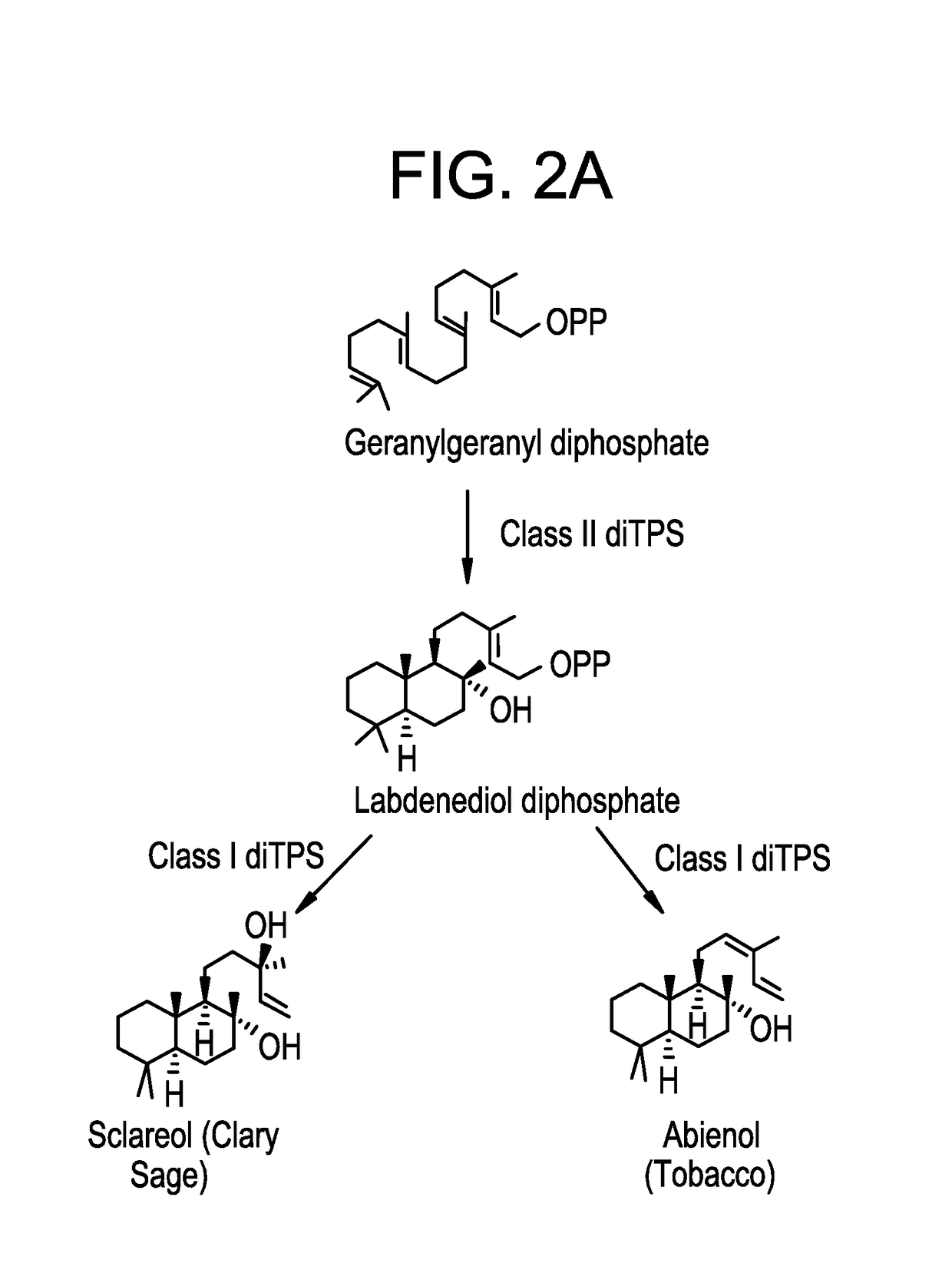Methods for producing abienol
a technology of abienol and expression vector, which is applied in the direction of lyase, transferase, enzymology, etc., can solve the problems of limited supply of animal or plant based fragrance and low production rate of abienol based on the existing methods, and achieve the effect of increasing the production rate of abienol
- Summary
- Abstract
- Description
- Claims
- Application Information
AI Technical Summary
Benefits of technology
Problems solved by technology
Method used
Image
Examples
example 1
[0068]Construction of Vectors Containing the Class II diTPS Gene, the Bifunctional Class I / II Abienol Synthase
[0069]Plasmids that were constructed and used in the present disclosure are shown in Table 1.
[0070]The bifunctional class I / II abienol synthase gene of Abies balsamea (Ab-CAS) was codon optimized according to Yarrowia codon bias, and synthesized de novo. During the de novo synthesis the sequence 5′-TGCTAGCCACAAAA, containing an NheI restriction site and a typical Kozak sequence for enabling efficient translation initiation, was added immediately upstream of the presumptive ATG start codon. The sequence ACGCGT-3′, comprising an MluI restriction site, was added immediately downstream of the stop codon. This sequence was cleaved using NheI and MluI and ligated to pMB6655 cut with NheI and MluI to produce pMB6839. The resulting protein encoded by the Ab-CAS gene of pMB6839 is specified in SEQ ID No: 3. The class II diTPS gene of Nicotinia tabacum (Nt-Class II-diTPS) was cloned i...
example 2
[0075]Construction of Recombinant Host Cells Containing Class II diTPS and Bifunctional Class I / II Abienol Synthase Genes
[0076]In this example, the vectors containing class II diTPS and bifunctional class I / II abienol synthase genes were introduced into a host strain of Y. lipolytica.
[0077]The vectors described above were transformed into a Y. lipolytica strain (ML7206) which had previously been optimized for increased flux through the isoprenoid pathway. Host strain ML7206 is a prototrophic Y. lipolytica strain with the following genotype (MATB erg9-4789::ura3 {HMG-tr GGS carB}). Strain ML7206 was constructed by the introduction of heterologous genes under the control of constitutive promoters, coupled with several generations of crossbreeding, starting with MF350 and ATCC201249 as described in U.S. Pat. No. 7,851,199. The ERG9 gene, encoding squalene synthase, was replaced with a hypomorphic version harboring a point mutation (F317I) and an insertion of the URA3 gene (subsequentl...
example 3
[0079]Study of the Abienol Titer of the Recombinant Host Cells Containing a Class II diTPS Gene and a Bifunctional Class I / II CAS Gene
[0080]In this example, the productions of abienol in recombinant host cells described in Example 2 were examined.
[0081]The transformants described in Example 2 were grown in shake flasks on a rich medium (YPD) overlaid with a 10% volume of dodecane. Previous studies with isoprenoids have shown that the isoprenoid products are typically exported by microorganisms, and accumulate in a dodecane overlay. After growth at 28° C., 200 rpm, for 6 days, the dodecane fraction was removed from the shake flasks and analyzed by HPLC on a C18 column, with a photo-diode array detector. The HPLC set up consisted of a YMC PackPro C18 RS column [part # RS08503-1456WT 150×4.6 mm S3 μm] at a column temperature of 16° C., mobile phase consisted of a mixture of (400 mL Methanol, 100 mL Ethanol, and 0.1% Trifluoro-Acetic Acid) using an isocratic flow rate of 1 mL / min. The t...
PUM
| Property | Measurement | Unit |
|---|---|---|
| Fraction | aaaaa | aaaaa |
| Fraction | aaaaa | aaaaa |
| Fraction | aaaaa | aaaaa |
Abstract
Description
Claims
Application Information
 Login to View More
Login to View More - R&D
- Intellectual Property
- Life Sciences
- Materials
- Tech Scout
- Unparalleled Data Quality
- Higher Quality Content
- 60% Fewer Hallucinations
Browse by: Latest US Patents, China's latest patents, Technical Efficacy Thesaurus, Application Domain, Technology Topic, Popular Technical Reports.
© 2025 PatSnap. All rights reserved.Legal|Privacy policy|Modern Slavery Act Transparency Statement|Sitemap|About US| Contact US: help@patsnap.com



